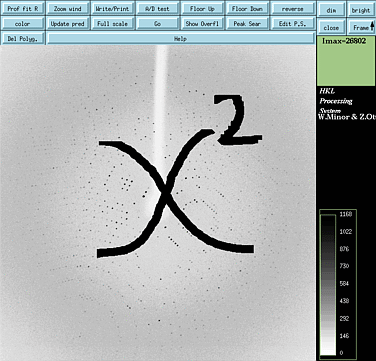|
|
|
|

courtesy of C. Kerfeld. |
Anomalous Differences: A
sample script
for the anomalous chi Squared test is given below.
The derivative data set should be processed with the "anomalous"
or "scale anomalous" flag in
scalepack (see below). And it should have at least four-fold redundancy.
This script compares intensities of Bijvoet pairs. These differences
are usually very small, so higher redundancy improves the accuracy
of anomalous signal.
Manual for Denzo:
|
|
|
|
|
scalepack << eof number of zones 8 estimated error 0.0 0.0 0.0 0.0 0.0 0.0 0.0 0.0 error scale factor 1.0 number of iterations 0 output file 'junk.sca' format scalepack file 1 'mydata_anom.sca' eof rm junk .sca |
We are licensed to use Scalepack on Sayre or Bayes.
Explanation: There are two types of chi**2 values mentioned in the paragragph above. (1) there is a chi**2 on symmetry related reflections and (2) there is a chi**2 on Bijvoet related reflections. In both types, chi**2 is an indication of the significance of the differences between two measurements. The larger the chi**2 is, the more significant the difference is. A chi**2 value of 1.0 means that the differences are insignificant. (1) The first chi**2 value compares symmetry related reflections within a data set. This chi**2 value should be close to 1.0 because symmetry releated reflection should agree well with each other. Therefore, the differences between symmetry related measurements should be insignificant. (2) The second chi**2 value compares Bijvoet related reflections within a data set. You want this value to be greater than 2.0. The larger this value is, the more significant are the anomalous differences. What is the value of adjusting the symmetry chi**2 close to 1.0? With every data set collected, you look at the chi**2 values to help you adjust the error model. The error model is adjusted so that Chi**2 is close to 1.0 in all resolution shells. When chi**2 is close to 1.0, then you have the best error model. Adjusting the error model applies a scale factor to the sigma value for each structure factor in the data set (but it does not change the structure factor value itself). Suppose you neglect to adjust the chi**2 values to 1.0. Suppose they are all greater than 1.0, then all the sigmas for your measurements will be set much lower than they actually should be, implying that your measurements are more accurate than they really are. Conversely, if the chi**2 are all less than 1.0, all the sigmas for your measurements will be set much higher than they actually should be, implying that your measurements are less accurate than they really are. How does the chi**2 of the symmetry related reflections affect the chi**2 test on anomalous differences? As mentioned above, the chi**2 test indicates the significance of the anomalous differences. The program judges the significance of the Bijvoet difference subtracting I(hkl)/sigma(hkl) from I(-h-k-l)/sigma(-h-k-l). You can see that this difference is very sensitive to sigma. If you neglected to adjust the chi**2 of symmetry related reflections to 1.0, then your sigma(hkl) and sigma(-h-k-l) values will be either too high or too low. If the chi**2 of the symmetry related reflections was greater than 1, then you risk getting a false positive result on the anomalous chi**2 test. If the chi**2 of the symmetry related reflections was less than 1, then you risk getting a false negative result on the anomalous chi**2 test
|
|
|
|
Here is the log file for a true seleno derivative of a 20 kD protein: The Rsym between anomalous pairs is around 4%. The Chi**2 values are greater than 2 throughout the resolution range. The derivative gave excellent phases. Stats provided courtesy of Celia Goulding. Shell Lower Upper Average Average
Norm. Linear Square
|
||